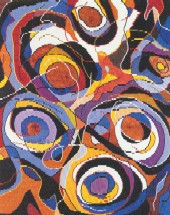

| Home | Art | Books | Order | Site Map |
 |
|
 |
|||||||||||
|
|||||||||||||
|
Arthur Secunda: Paintings and Engraved Wood Panels | ||||||||||||||||||||||||||||||||
by Dennis WepmanNote: Author Dennis Wepman, has known and collected Secunda's work for many years. He prepared this text for an exhibition of Secunda's work, which featured paintings and painted, engraved wood panels from the late 1980s and early 1990s.
Arthur Secunda never ceases to surprise us. In the 1960s the daring social statements of his bold collages were a sensation; in the 1970s he created haunting abstract landscapes with strips of torn paper which, with the popular and much-imitated prints they generated, were to become one of the established graphic conventions of the decade. Throughout his career Secunda has experimented with innovative techniques in mixed media, molded hand-made paper, serigraphs, lithographs, etchings, and woodcuts. But Secunda has never been one to milk his successes dry. Since his first public exhibition, in Paris in 1949, his restless imagination and boundless creative energy have driven him to explore new materials, media, and means of expression. Now, as the century enters its last decade, he has once more presented the public with a series of works unlike anything he - or anyone else - has done before. 
Secunda's recent paintings, in every permutation of oil, acrylic, enamel, and mixed media on canvas, wood, and paper, are a new departure; and yet it may be said of him as of any authentic artist that a thread of continuity binds his latest work with what has come before. Plus ca change, plus c'est la meme chose: the harmonious integration of line and mass, the luminous color, and the elegant poise that characterized his torn-paper collages; the rhythmic flow and the dynamic composition of his abstractions; and the spontaneity and the sensuous modeling of the impressionistic nudes he executed in the 1980s, all come together in these new creations. Secunda never stands still, but he doesn't seek novelty for its own sake. Every innovation contains an identifiable link to the past, his own and that of the history of art. Secunda comes by the range and depth of his oeuvre naturally. After acquiring a solid foundation in art at New York University and the Art Students League, he went on to the Acad6mie de la Grande Chaumi~re in Paris and studied sculpture with Ossip Zadkine and painting with Andr6 Uhote. A founder of Art Forum, he has served as artist-in-residence at the Centre Genovois de Gravure Contemporain in Geneva and worked as art critic, museum curator, university instructor, media personality, illustrator, and ceramic designer. 
His work has been exhibited worldwide: in Paris, Brussels, Geneva, Hamburg, Stockholm, Barcelona, Florence, and Athens; in Ontario, New York, Boston, Washington, Chicago, Los Angeles, and Honolulu; in Jerusalem, Tel Aviv, Seoul, and Tokyo. It has received over 100 solo shows and been reproduced widely in books and magazines. He even has helped NASA identify colors that would effectively convey digital images from space. Paintings and prints by Secunda are in the permanent collections of the New York Public Library, the Library of Congress, the Smithsonian Institution, the Bibliotheque National of Paris, the National Gallery in Washington, New York's Museum of Modern Art, Chase Manhattan Bank, the Bank of America, Sears, and Standard Oil. Now represented by Nahan Galleries, with locations in New Orleans, New York, and Tokyo, Secunda is an international presence in the world of art. The work now issuing from the studios Secunda maintains in Los Angeles and Paris reflects all the wide and diverse experience of his career, but as always it contains something new and surprising. Whimsical yet powerful, it reveals a resurgence of vitality. Its intricate and sophisticated patterns include a range from stylized, almost caricatural figuration to pure abstraction, but it never fails to radiate that exuberant joie de vivre that has always been a hallmark of Secunda's work. Its colors go from jellybean shades to rich, mottled hues, its compositions from classically simple to incredibly complex, according to the aesthetic objectives of the work. 
The chaos and pain of Berlin Wall, an abstract curvilinear composition reveals that Secunda has lost nothing of his passionate concern for the human community; the electric energy of "Mr. Charles Parker," a portrait of the saxophonist composed of harlequin patches with music flying from his horn like golden lightening, reminds us that Secunda himself once made a living as a jazz musician; the almost continuous line which forms "La Danse" dances across the wood panel with the abandon of a maenad. Not all of Secunda's recent painting is pictorial. A psychological note appears in such work as "Man Unravelling Himself," a doubled image formed by a flowing line that appears to be coming undone; "Getting Free" contains a psychedelic, fragmented silhouette breaking out of the kaleidoscope of brilliant-colored geometric shapes imprisoning him; and in "L'Avenir" ("The Future"), a primordial human figure, stylized almost to abstraction, stands framed in multiple boxes--all speaking eloquently of the interior life. 
Not content with the dynamic of paint alone, Secunda has created a sort of bas-relief in many of these works by gouging deep grooves in the wood panels on which they are painted. Filled with color, they produce a kinetic vibrancy which no fiat surface could achieve. Traffic on Boulevard Brune has the animation of graffiti with its scribbly red bus and blue car against a confused maze of glowing yellow-green lines. By turns animated and poised, sensuous and austere, somber and playful, the artist reveals his assurance and control of whatever method and medium he undertakes. Variety is an essential element in his career, but never as an expression of fatigue or satiety. He moves on, not in retreat but in pursuit. For Arthur Secunda, every new departure is an arrival.
|
|||||||||||||||||||||||||||||||||
|
| Home |
Art |
Books | Order | Contact Us | Site Map | Admin | |
|
|
© 2002-2025 Pierian Press. All rights reserved. |